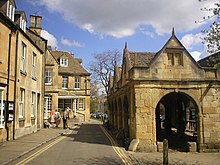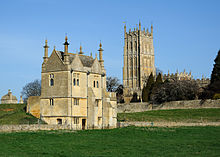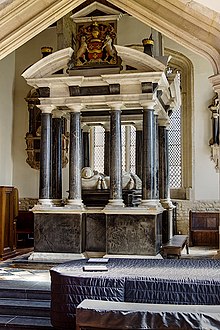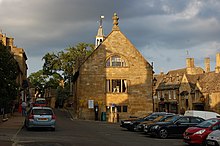Chipping Campden
| Chipping Campden | |
|---|---|
 St James' church | |
Location withinGloucestershire | |
| Population | 2,288 (2011 Census) |
| OS grid reference | SP155395 |
| Civil parish |
|
| District | |
| Shire county | |
| Region | |
| Country | England |
| Sovereign state | United Kingdom |
| Post town | CHIPPING CAMPDEN |
| Postcode district | GL55 |
| Police | Gloucestershire |
| Fire | Gloucestershire |
| Ambulance | South Western |
| UK Parliament | |
Chipping Campdenis amarket townin theCotswolddistrict ofGloucestershire,England. It is notable for its terraced High Street, dating from the 14th century to the 17th century. ( "Chipping" is fromOld Englishcēping,'market', 'market-place'; the same element is found in other towns such asChipping Norton,Chipping Sodburyand Chipping (now High)Wycombe.[2])
Awooltrading centre in theMiddle Ages,Chipping Campden enjoyed thepatronageof wealthy wool merchants, most notablyWilliam Greville(d.1401). The High Street is lined with buildings built from locallyquarriedooliticlimestoneknown asCotswold stone,and boasts a wealth ofvernacular architecture.Much of the town centre is aconservation areawhich has helped to preserve the original buildings.[3]The town is an end point of theCotswold Way,a 102-milelong-distance footpath.
Chipping Campden has hosted its own Games since 1612.
History
[edit]


One of the oldest buildings in the town is the Grade I listed Market Hall, built in 1627 by SirBaptist Hicksin 1627 and still in use. The building was intended as a shelter for merchants and farmers selling their wares with thearchedside walls open to allow light, and customers, to enter.[3]There was a plan to sell the hall in the 1940s but locals raised funds to purchase the property and donated it to theNational Trust.[4]
The grandearly perpendicularCotswoldwool church,Church of St James,with itsmedievalaltar frontals(c. 1500),cope(c. 1400), and 17th centurymonumentsincludes a monument to silk merchant Sir Baptist Hicks and his family. As well, the Grade I listed Church of St James includes a plaque to William Grevel, described as "the flower of the wool merchants of all England". His home, the Grade I listed Grevel's House, was built c. 1380. It is not open to visitors.[3][5]
The Grade I listedalmshouseson Church Street were built in 1612, provided by Sir Baptist Hicks as homes for 12 pensioners and still remains in use for that purpose. The Old Silk Mill in Sheep Street, Grade II listed, is a three-storey building originally used as a mill for spinning of silk thread; it closed in 1860 and became asilk throwingmill.[6]In 1902, the building was converted into the headquarters for the Guild of Handicraft.[3]The Court Barn near the church is now a museum celebrating theArts and Craftstradition of the area.
Hicks was also the owner of Campden House, on land he purchased some time after 1608; he added the manor and gained the title 1st Viscount Campden. The manor was destroyed by Royalists in 1645 during theEnglish Civil Warpossibly to prevent it falling into the hands of theParliamentarians.[7]There is little reliable evidence as to the appearance of the manor and gardens. Any drawings of the house were made long after it had been destroyed.[8]All that now remains of Sir Baptist Hicks' once imposing estate are a gatehouse and twoJacobeanbanqueting houses;[7]the latter were restored by theLandmark Trust.[9]Lady Juliana Noel, Sir Baptist's daughter, and her family lived at the converted stables near the site in Calf Lane, now called the Court House.[10]Her descendant still lives in that Grade II listed building.[7][11]
In 1970 the High Street and much of the town centre was designated a conservation area to preserve the architecture.[12]
There are two historic gardens nearby: the Arts and CraftsHidcote Manor Garden,owned and managed by the National Trust, and another at nearby Mickleton,Kiftsgate;this site is privately owned, but open to the public. Two miles to the west, in the grounds ofWeston Parknear Saintbury, are the earthwork remains of amotte-and-bailey castle.[13]
Governance
[edit]
The town falls within 'Campden-Vale'electoral ward.This ward stretches north from Chipping Campden toMickleton.The ward population taken at the2011 censuswas 5,888.[14]Local governmentconsists of a town council of 11 councillors. One councillor is selected to serve as mayor for a term of 12 months. Chipping Campden Council meets on the second Tuesday of every month inChipping Campden Town Hall.Council meetings are open to the public with time set aside for public questions.
Schools
[edit]There are two primary schools, St James’ & Ebrington Church of England and St Catharine's Catholic and one secondary school, Chipping Campden School.[15]
Public transport
[edit]
TheCotswold Linepasses near Chipping Campden, but the town'srailway stationclosed in 1966. Since 2014, there have been proposals to reopen it.[16]Regular trains currently stop atMoreton-in-Marsh,eight miles away, from whereOxfordis a 26-49 minute ride andLondon Paddingtoncan often be reached in less than 90 minutes.
Buses are available toStratford-upon-Avon,Moreton-in-MarshandCheltenham.[17]
Cotswold Games
[edit]
Since the early seventeenth century, the town has been home to a championship of rural games, which later turned intoRobert Dover'sCotswold Olimpick Games.The games were discontinued in 1852 but revived in 1963 and still continue.[18]
The Olimpicks are held every summer on the Friday evening following the late Spring Bank-holiday (usually late May or early June), on Dover's Hill, near Chipping Campden. Peculiar to the games is the sport of shin-kicking (hay stuffed down the trousers can ease one's brave passage to later rounds).
To mark the end of the games, there is a huge bonfire andfireworkdisplay. This is followed by a torch-lit procession back into the town and dancing to a local band in the square. The Scuttlebrook Wake takes place the following day. The locals don fancy dress costumes and follow the Scuttlebrook Queen, with her four attendants and Page Boy, in a procession to the centre of town pulled on a decorateddrayby the town's own Morris Men. This is then followed by the presentation of prizes and displays of Maypole and Country dancing by the two primary schools andMorris dancing.Another procession from there past the fairground in Leysbourne and the Alms Houses brings that stage of the celebration to a close whilst the fair continues until midnight and, like a ghost, is gone by the morning.
The 2019 Games agenda included events such as a children's half-mile Junior Circuit, a Championship of the Hill race for adults and a Tug O’War competition. The organizers also planned fireworks, a torchlit procession, marching bands and cannons firing.[19]
Media
[edit]Local news and television programmes are provided byBBC West MidlandsandITV Central.Television signals are received from either theSutton Coldfieldor Lark Stoke TV transmitters.[20]
The town is served by bothBBC CWRandBBC Radio Gloucestershire.Other radio stations areHeart West,Greatest Hits Radio South West,Capital Mid-Counties,andNorth Cotswold Community Radio,a community-based station which broadcasts from the town.[21]
The town's local newspapers are theChipping Campden Bulletin,[22]Evesham Observer[23]andCotswold Journal.[24]
Music
[edit]Since 2002 Chipping Campden has hosted what is now widely recognised as one of the UK's leading music festivals. The 2020 Festival had been scheduled to run from May 9 to 23, but was cancelled due to theCovid-19 pandemic.[25]
Arts and Crafts movement
[edit]
In the early 20th century, the town became known as a centre for the CotswoldArts and Crafts Movement,following the move ofCharles Robert Ashbeeand the members of hisGuild and School of Handicraftfrom theEast End of Londonin 1902. According to the local historical society, the movement "focused on handmade objects, reacting against the rapidly growing dominance of machinery which resulted in the loss of craft skills".[6]The Guild of Handicraft specialised in metalworking, producing jewellery and enamels, as well as hand-wrought copper and wrought ironwork, and furniture-making. According toHistoric England,"the Guild of Handicraft, founded by Ashbee in 1888, became one of the foremost Arts and Crafts workshops of its period.. formed the focus of the communal life which, as a pioneering social experiment, formed the most bold and important expression of Arts and Crafts principles".[26]The Guild ceased operation in 1907 but the centre for crafts offers a permanent exhibition of their work.[27][28]
A number of artists and writers settled in the area, includingF. L. Griggs,the etcher, who built Dover's Court (now known as New Dover's House), one of the last significant Arts and Crafts houses. He set up the Campden Trust in 1929 withNorman Jewsonand others, initially to protect Dover's Hill from development. According to a 2018 report, Griggs "sympathetically restored houses on the High Street, battled against a tide of ugliness that engulfed other towns and villages and used money he could ill afford to safeguard its surroundings". In 1934, he raised funds to buy the Coneygree field (where rabbits had been raised generations earlier) for the National Trust to ensure its protection.[29][30]Many of Griggs' etchings are preserved at theAshmolean MuseuminOxford.[31]
H. J. Massingham,the rural writer who celebrated the traditions of the English countryside, also settled near the town, as didArthur Gaskin.Ananda Coomaraswamy,the Sri Lankan philosopher and art critic and his wife the handloom weaverEthel Mairet,settled atBroad Campdenwhere Ashbee adapted theNormanchapel for him.[32]
In 2005, a group of traditional craftspeople moved into The Old Silk Mill building. As of 2019, there were 28 members of this co-operative.[33]
Notable people
[edit]- Graham Greene,English novelist, playwright, short story writer and critic, lived, between 1931 and 1933,[34]with his wifeVivien Greeneat "Little Orchard" in the town.[35]
- Ernest Wilson,plantsman, was born in the town. A memorial garden is dedicated to him.[36]
- SirPercy Hobart,armoured vehicle strategist and commander of the 79th Armoured Division in theSecond World War,came from Chipping Campden and led theHome Guardthere during the war.
- Frederick Landseer Maur Griggshas a commemorative plaque in the town.
- SirGordon Russell(1892-1980), celebrated furniture designer and maker, went to school in Chipping Campden and built his home, Kingcombe, here in 1925. He lived at Kingcombe until he died.[37]
Arms
[edit]
|
Twin towns – sister cities
[edit]Chipping Campden istwinnedwith:[39]
 Pont-d'Ouilly,France
Pont-d'Ouilly,France
See also
[edit]- The Campden Wonder
- Chipping Campden School
- Court Barn MuseuminChipping Camden:Life and works of Charles Ashbee and other members of theGuild and School of Handicraft
References
[edit]- ^"Chipping Campden Town Council - Part of Campden Online".Chipping Camdpen Town Council.Archived fromthe originalon 24 October 2017.Retrieved19 April2018.
- ^A.D. Mills,Oxford Dictionary of English Place-Names(Oxford University Press, 1998), p. 83.
- ^abcdLeigh, Jane (3 February 2021)."A warm welcome from Chipping Campden".Great British Life.Retrieved11 June2021.
- ^"Chipping Campden Market Hall".Britain Express.
- ^Historic England."Church of St James (1341977)".National Heritage List for England.
- ^ab"The Old Silk Mill".Chipping Campden History.
- ^abc"Baptist Hicks (1551 - 1629)".Cotswolds Info.
- ^"Background to the Campden House Project".Chipping Campden History.
- ^"Sir Baptist Hicks".Landmark Trust.
- ^Historic England."Court House (1342016)".National Heritage List for England.
- ^"The Times & The Sunday Times".thetimes.co.uk.Retrieved19 April2018.
- ^"Chipping Campden Tourist Information Guide".Cotswolds Info.
- ^"Saintbury Castle - South West - Castles, Forts and Battles".castlesfortsbattles.co.uk.Retrieved19 April2018.
- ^"Campden-Vale ward 2011".Retrieved22 March2015.
- ^"Let's move to Chipping Campden, Gloucestershire".The Guardian.16 February 2018.
- ^"8.6 Chipping Campden".Local Plan Reg. 18 Consultation: Development Strategy and Site Allocations January 2015.Cotswold Council.Retrieved2 July2020.
- ^"Chipping Campden – bustimes.org".bustimes.org.
- ^"Robert Dover's Cotswold Olimpick Games".Visit Gloucester.
- ^"Robert Dover's Cotswold Olimpick Games".So Gloucester.
- ^"Full Freeview on the Lark Stoke (Gloucestershire, England) transmitter".UK Free TV.1 May 2004.Retrieved18 December2023.
- ^"North Cotswold Community Radio".Retrieved18 December2023.
- ^"The Chipping Campden Bulletin".Retrieved18 December2023.
- ^"Evesham Observer".British Papers.15 February 2014.Retrieved18 December2023.
- ^"Cotswold Journal".British Papers.19 March 2014.Retrieved18 December2023.
- ^"Chipping Campden Music Festival".Campdenmusicfestival.co.uk.Retrieved3 May2020.
- ^Historic England."The Old Silk Mill (1342026)".National Heritage List for England.
- ^"Arts and Crafts".Cotswold Council. Archived fromthe originalon 28 May 2019.Retrieved29 September2019.,Arts & crafts
- ^"C R Ashbee and The Guild of Handicraft".Chipping Campden History.
- ^"How an Arts-and-Crafts architect fought to preserve the beauty of Chipping Campden".County Life.
- ^"Facts around the town".Campden Life. Archived fromthe originalon 28 September 2019.Retrieved29 September2019.
- ^Griggs, F. L."Visions of England".Oxford University Press.
- ^Historic England."Norman Chapel and boundary wall (1341989)".National Heritage List for England.
- ^"The Gallery at the Guild".
- ^"Campden Cottages".Archived fromthe originalon 2 October 2012.Retrieved13 September2011.Campden Cottages web site
- ^Vivien Greene ObituaryThe Guardian(London), 23 August 2003
- ^"Chipping Campden Tourist Information Guide".
- ^Designer's Trade, Gordon Russell
- ^"CHIPPING CAMPDEN TOWN COUNCIL (GLOUCESTERSHIRE)".Civic Heraldry of England.Retrieved20 March2022.
- ^"Chipping Campden celebrates twinning anniversary with French town".Evesham Journal.29 June 2023.
External links
[edit] Chipping Campdentravel guide from Wikivoyage
Chipping Campdentravel guide from Wikivoyage
- Chipping Campden's Official Website
- All About Chipping Campden, a Town Guide, a site run by the town for the town
- .Encyclopædia Britannica.Vol. 6 (11th ed.). 1911. p. 238.
| Following theCotswold Way | |
|---|---|
| Towards Bath | Towards Chipping Campden |
| 9 km (6 miles) to Broadway | to - |

